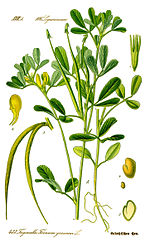De agri cultura ([deː ˈaɡriː kʊlˈtuːraː]), also known as On Farming or On Agriculture, is a treatise on Roman agriculture by Cato the Elder. It is the...
7 KB (914 words) - 16:55, 9 August 2024
as the Greek poems of Archestratos and Antiphanes, as well as the De agri cultura of Cato the Elder. It is often seen as the predecessor of baklava and...
14 KB (1,409 words) - 10:22, 21 October 2024
Cato the Elder (category CS1 German-language sources (de))
Origines, a now fragmentary work on the history of Rome. His work De agri cultura, a rambling work on agriculture, rituals, and recipes, is the oldest...
53 KB (6,788 words) - 17:19, 25 October 2024
Civitate Dei VII 11 & 12. Frugifer CIL XII 336. Apuleius De Mundo 37. Cato De Agri Cultura 132; Paulus s. v. p. 51 M. CIL VI 3696. Wissowa (1912), p...
138 KB (19,053 words) - 19:39, 25 October 2024
tradition are mostly from the Roman agronomists: Cato the Elder's De agri cultura, Columella's De re rustica, Marcus Terentius Varro and Palladius. Attributed...
39 KB (5,453 words) - 01:57, 15 September 2024
history in many cultures. The Roman writer Cato (in his De agri cultura) and Columella (in his De re Rustica) mentioned preserving cabbages and turnips...
33 KB (3,331 words) - 16:08, 1 November 2024
Cato the Elder. De Agri Cultura. p. 27. Curry A (February 2010). "A 9,000-Year Love Affair". National Geographic. 231 (2): 46. Josephus, De Bello Judaico...
20 KB (2,198 words) - 01:38, 21 October 2024
Palatschinke (category CS1 German-language sources (de))
and Antiphanes first mentioned plakous. Cato the Elder's short work De agri cultura ("On Farming") from about 160 BC includes an elaborate recipe for placenta...
9 KB (816 words) - 16:32, 24 October 2024
Empire and was mentioned as early as Cato the Elder's 160 BCE piece De Agri Cultura. Traditionally, composting involved piling organic materials until...
67 KB (7,757 words) - 13:28, 30 September 2024
used for numerous purposes, as first described by Cato the Elder in De Agri Cultura, and later by Pliny the Elder. Cato mentions its uses as a building...
3 KB (276 words) - 12:57, 25 August 2024
The earliest extant cheesecake recipes are found in Cato the Elder's De Agri Cultura, which includes recipes for three cakes for religious uses: libum,...
22 KB (2,128 words) - 15:33, 29 October 2024
tiropita. A recipe in Greek tradition recorded in Cato the Elder's De Agri Cultura (160 BC) describes placenta as a sweet layered cheese dish: Shape the...
7 KB (722 words) - 15:05, 6 July 2024
described by Columella (Res rustica, I.8, XI.1, and XII.1), and by Cato (De Agri Cultura, cxlii–cxliii, focusing on the vilica; v on the vilicus). The vilica...
4 KB (560 words) - 14:50, 27 October 2024
ISBN 978-3-468-11492-2. Marcus Porcius Cato, De Agri Cultura 1.5.4/5 Marcus Porcius Cato, De Agri Cultura 1.5.4/5 Marcus Tullius Cicero, Philippicae 12...
11 KB (636 words) - 20:47, 18 October 2024
for a deep-fried dough ball was recorded by Cato the Elder in his de agri cultura, using cheese, honey, and poppy seeds, called globi. Similar types...
92 KB (10,575 words) - 22:51, 21 October 2024
documentation of preserving cheese in brine appears in Cato the Elder's De Agri Cultura (2nd century BC), though the practice was surely much older. It is...
32 KB (3,445 words) - 06:38, 6 November 2024
Associazione Tuscolana Amici di Frascati, 1978. Marcus Porcius Cato: De Agri Cultura, 160 B.C. "Gazzetta n. 240 del 14 ottobre 2011 (vai al sommario) MINISTERO...
3 KB (356 words) - 07:41, 20 August 2024
Tigillum Sororium see also the section that follows. Livy VIII 9, 6 Cato De Agri Cultura 141 and 143. Acta Fratrum Arvalium ed. Henze p. CCXIV and 144 ff. Some...
119 KB (18,046 words) - 23:59, 27 October 2024
Fig (redirect from Larme de Jaune)
common food source for the Romans. Cato the Elder, in his c. 160 BC De Agri Cultura, lists several strains of figs grown at the time he wrote his handbook:...
53 KB (5,681 words) - 22:40, 27 October 2024
Ham (redirect from Jambon de Paris)
century BC. Cato the Elder wrote about the "salting of hams" in his De agri cultura tome around 160 BC. There are claims that the Chinese were the first...
25 KB (2,357 words) - 09:05, 7 July 2024
(1979). Historia de Roma (Third ed.). Madrid: Akal Editor. ISBN 84-7339-455-0. p. 178 (in Latin) Rerum Rusticarum de Agri Cultura online in the original...
60 KB (7,862 words) - 23:19, 28 August 2024
Epistulae, book 1, epistle XIX by Horace, 20 BC (in Latin) Res Rusticae – De agri cultura Fumagalli, Giuseppe (1987). L'ape latina: dizionarietto di 2948 sentenze...
12 KB (225 words) - 05:30, 26 October 2024
160 BC, Roman statesman Marcus Porcius Cato (234–149 BC), who wrote De Agri Cultura, notes the recipe for the most popular pie/cake called placenta. Also...
33 KB (4,239 words) - 15:49, 5 November 2024
ceremonies. The ritual for private fields is preserved in Cato the Elder's De Agri Cultura, "On Agriculture". The first step was to lead the three animals around...
14 KB (1,589 words) - 14:55, 1 November 2024
recipes are known starting in the 2nd century BCE with Cato the Elder's De Agri Cultura. Many authors of this period described eastern Mediterranean cooking...
23 KB (2,188 words) - 10:54, 1 November 2024
the Elder who included a recipe with the name "balloons" in his book De Agri Cultura, which was written in the second century BC. In that recipe, flour...
15 KB (1,592 words) - 05:04, 29 August 2024
tiny proportion is crafted by hand. Since at least the time of Cato's De Agri Cultura, basic pasta dough has been made mostly of wheat flour or semolina...
70 KB (8,262 words) - 17:19, 4 November 2024
When ready, honey is poured over the placenta. — Cato the Elder, De Agri Cultura 160 BC According to a number of scholars, koptoplakous (κοπτοπλακοῦς)...
55 KB (5,233 words) - 17:17, 26 October 2024
early Roman wine presses and how to build a press room in his work De Agri Cultura. The press Cato describes was known as a lever or beam press which...
20 KB (2,726 words) - 23:52, 1 September 2024
Augustine CD VII 11 end and 12. Frugifer CIL XII 336. Apuleius De Mundo 37. Cato De Agri Cultura 132; Paulus s. v. p. 51 M. CIL VI 3696. Wissowa above p. 105...
30 KB (4,424 words) - 13:00, 4 September 2024



























